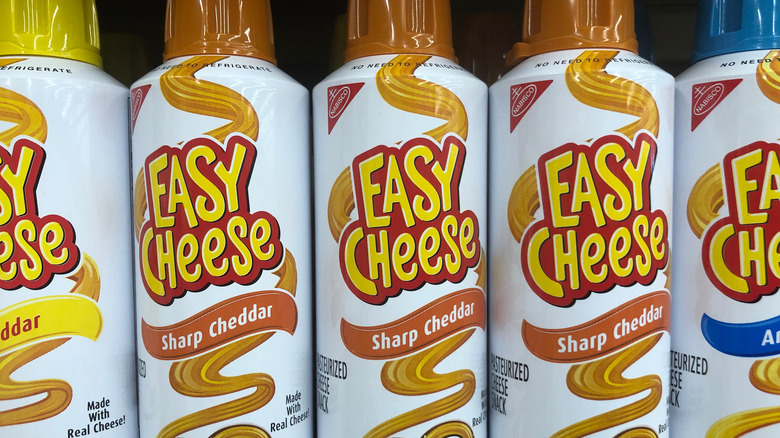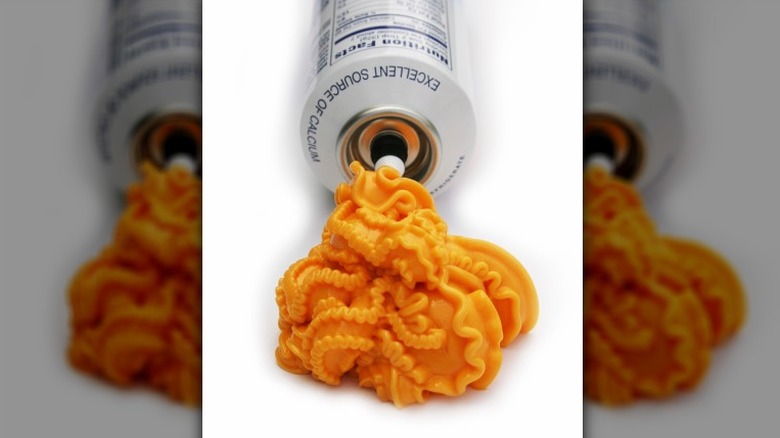Here's What's Actually In Those Weird Canned Cheese Sprays
In the world of processed foods, one item stands out as seeming especially unnatural: sprayable cheese. Not to be confused with Cheez Whiz, which is a sauce, spray cheese comes in a pressurized can, similar to cans of whipped cream. Without a doubt, the most widely-known brand in the spray-cheese game is Nabisco's Easy Cheese, which is marketed by Kraft. But many in-house labels, including Kroger and Walmart's Great Value, make their own smooth, airy, and vibrantly orange versions. It shouldn't surprise anybody to learn that canned cheese spray is not the most natural offering at the grocery store, but the full spectrum of ingredients, as well as its potential impact on your health, may surprise you.
Let's start with the first thing you notice about spray cheese: the can itself. It may not be an "ingredient" in the traditional sense, but it's important to address, as there are misconceptions about this technology. Aerosol cans use compressed gas as a propellant, but spray cheese is not a "true aerosol," meaning the food and propellant don't mix.
Instead, spray cheese cans are divided into two portions. The upper portion contains the cheese mixture while the lower portion contains nitrogen gas. These are divided by a plastic barrier and a piston, which together act as a sort of plunger, pushing the spray cheese up and out. You're not consuming any of the gas within the can, but you are consuming a number of other things, and cheese isn't even the main ingredient.
Spray cheese only contains trace amounts of cheese
If you look at the label on a can of Easy Cheese, for example, you'll notice that cheddar cheese is only the fourth ingredient listed. The number one ingredient is actually whey, which is the liquid left over after you turn milk into cheese. The whey in Easy Cheese is a byproduct that the manufactuer repurposes. It's cheaper than using real cheese as the primary ingredient, which is a big reason for spray cheese's low price point.
The second ingredient is canola oil, which prevents the can's contents from solidifying, keeping it sprayable. After that, you have milk protein concentrate (M.P.C.), which is the protein left from filtering milk. Once those three are out of the way, you finally get to the actual cheese, which is made from milk, salt, cheese culture, and enzymes.
Then, in no particular order, we come to the additives that really raise some eyebrows, like sodium phosphate, which is an emulsifying agent used to keep the oil in the cheese spray from separating. Sodium citrate is added for the same purpose. You also have calcium phosphate, the ingredient that gives companies the legal ability to label such products as good sources of calcium. Additionally, there's sorbic acid for preservation, and annatto extract to give it that orange hue.
The health implications of spray cheese
With canned spray cheese appearing so overtly synthetic, its contents have been subjected to great scrutiny by nutritionists. It probably won't surprise you to learn that spray cheese comes with a number of health concerns. So, keep those hopes nice and low as we dive into all the questionable details.
The top of the ingredients list may reveal some cost-cutting measures in the use of whey and M.P.C. over real cheese, but the true concerns begin when we get to the preservatives and emulsifiers. According to The National Kidney Foundation, sodium phosphate can cause phosphate crystals to build up in the kidneys, potentially leading to renal failure. Nevertheless, it's generally recognized as safe by the F.D.A.
Now, let's talk about calcium phosphate, which as previously mentioned, allows processed cheese brands to brag about their calcium content. Notably, high phosphorus levels inhibit the body's ability to use calcium, per Mount Sinai. As you can see, this stuff is best eaten in moderation, but let's be honest: Did you expect anything different from sprayable cheese?


